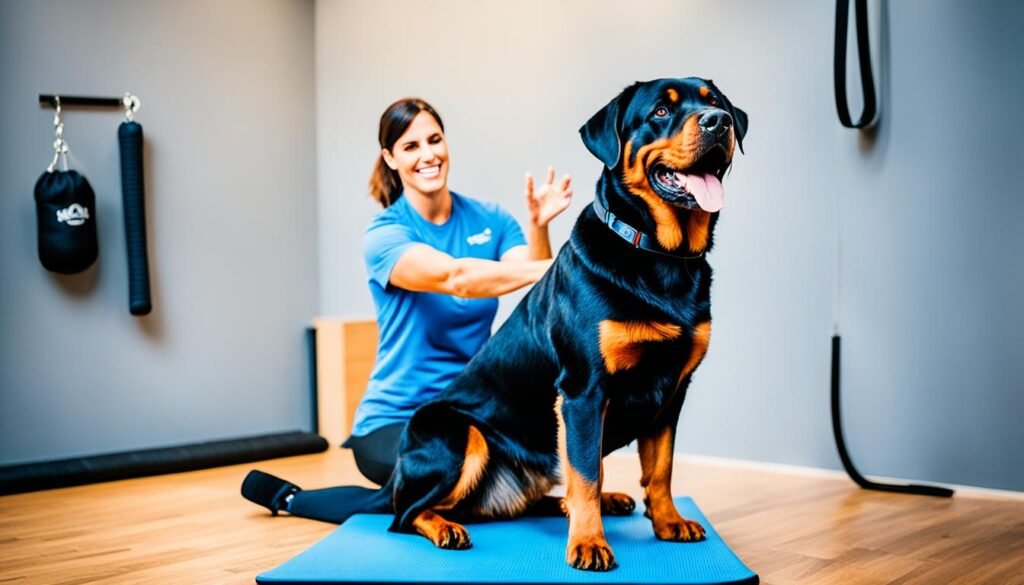Training Rottweilers can be a topic of concern for many dog owners. With their powerful physique and natural guarding instincts, it’s important to understand how to train them effectively.
Many people wonder, “Are Rottweilers hard to train?” While they may have a reputation for being strong-willed, Rottweilers can actually be quite trainable with the right approach and consistent guidance.
Key Takeaways:
- Rottweilers can be trained effectively with the right approach and consistent guidance.
- Understanding the breed’s characteristics is important for successful training.
- Consistency and positive reinforcement are key to training a Rottweiler.
- Starting training at a young age can help establish good behavior.
- Addressing behavior issues through training can prevent future problems.
About Rottweilers
Rottweilers are a versatile and robust breed that originated from the mastiffs of the Roman Legion. They have a rich history as working dogs and are renowned for their strength, intelligence, and loyalty. As natural protectors, Rottweilers make excellent family pets and guardians.
Male Rottweilers typically measure between 24 to 27 inches at the shoulder, displaying a sturdy and muscular physique. They have a distinctive short black coat with rust-colored markings, commonly referred to as “rut.” This iconic coat, along with their sharp, alert expression, adds to their formidable appearance.
Despite their strong presence, Rottweilers are known for their gentle nature and enjoy playing with family members, including children. They possess a calm and confident disposition, which makes them capable of handling different situations with ease.
Proper breeding and early training are essential to bring out the best in Rottweilers. By providing a nurturing environment and consistent socialization experiences, their natural territorial instincts can be channeled into positive behaviors. This enables them to become well-rounded companions that thrive in loving homes.
Training Rottweilers - Easy or Difficult?
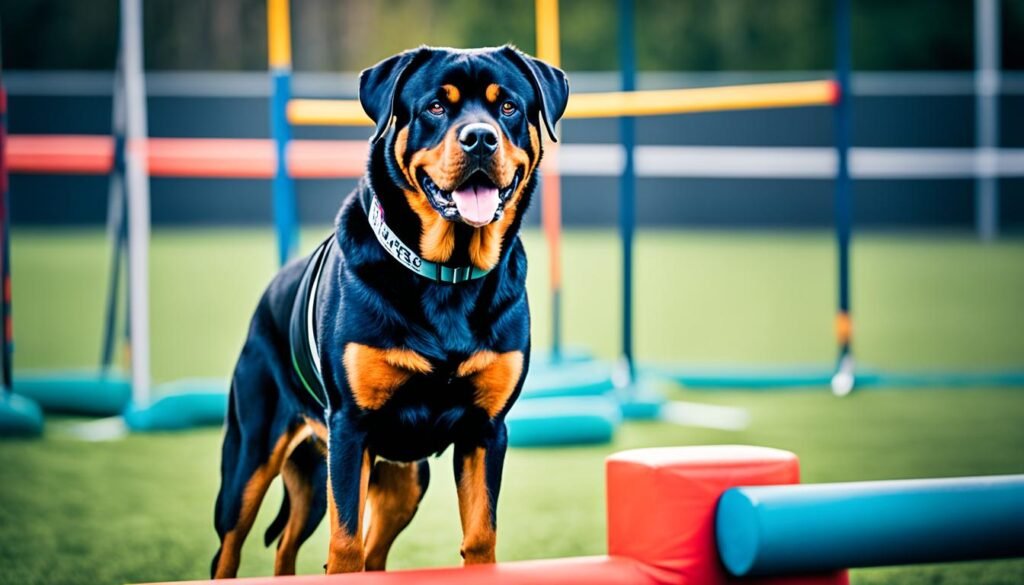
When it comes to training Rottweilers, many people wonder if it is an easy or difficult task. Well, with the right approach and techniques, training Rottweilers can be a breeze. Rottweilers are known for their intelligence and eagerness to please their owners, which makes them highly trainable and responsive to commands.
However, it is important to keep in mind that training any dog requires patience and consistency, and Rottweilers are no exception. They have a relatively short attention span, so ongoing commitment and positive reinforcement are necessary for successful training.
One of the reasons why Rottweilers are easy to train is because of their intelligence. They have a natural ability to understand and learn new things quickly. This, combined with their desire to please their owners, makes them highly responsive to training.
To effectively train a Rottweiler, it is important to establish yourself as a leader and set clear boundaries. Consistency is key, as Rottweilers respond well to routine and structure. Positive reinforcement, such as treats and praise, helps to reinforce good behavior and motivate them during training sessions.
In addition to being intelligent, Rottweilers also have a strong desire to work and learn. They enjoy being challenged and thrive in environments where they can use their physical and mental abilities. Engaging exercises and interactive games can help keep them stimulated and focused during training.
Overall, training Rottweilers can be a rewarding experience. With their intelligence, eagerness to please, and natural desire to work, they are relatively easy to train. However, it is important to approach training with patience, consistency, and positive reinforcement to ensure success. Remember, a well-trained Rottweiler is a happy and well-behaved companion.
Why Rottweilers Are Easy to Train

Rottweilers are renowned for their intelligence and obedience, making them a breed that is relatively easy to train. Their inherent intelligence allows them to quickly grasp instructions and concepts, making teaching them new commands a breeze. This level of intelligence also contributes to their ability to problem-solve and adapt to various training methods.
Rottweilers respond particularly well to positive reinforcement, making training sessions not only effective but also enjoyable for both the owner and the dog. Praising and rewarding Rottweilers for good behavior reinforces positive associations and encourages them to repeat desired actions.
Furthermore, Rottweilers have a strong desire to please their owners. Their loyalty and eagerness to work and learn make them highly motivated during training sessions. This makes the training process smoother and more productive, as they are genuinely interested in engaging with their owners and performing well.
Consistency is key when training Rottweilers. By providing a balanced approach that combines structure, clear expectations, and positive reinforcement, owners can foster mutual trust and understanding with their Rottweiler. Regular and consistent training sessions help establish routines and reinforce desired behaviors, allowing Rottweilers to internalize commands and respond reliably.
Whether it’s mastering basic commands or learning more complex tasks, Rottweilers have the capacity and willingness to excel in training. Their intelligence, responsiveness to praise, loyalty, and eagerness to please their owners all contribute to their adaptability and ease of training.
Overall, Rottweilers are an intelligent breed with a natural inclination towards obedience. With positive reinforcement, consistent training, and a nurturing environment, they can become well-behaved and highly trained companions.
Challenges in Rottweiler Training
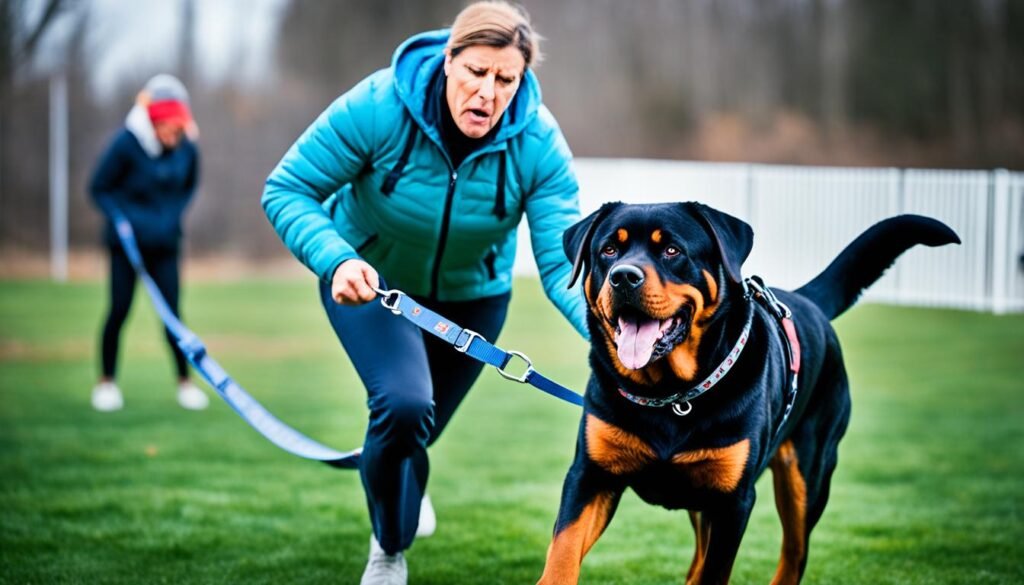
Training a Rottweiler can come with its fair share of challenges, especially when dealing with their strong-willed and stubborn nature. This is particularly evident during their puppyhood when they may assert dominance and resist repeated commands.
Establishing leadership is crucial when training a Rottweiler. By consistently asserting yourself as the leader, you can overcome their stubbornness and successfully guide them through their training journey.
During training sessions, it’s important to maintain consistency. Rottweilers respond well to knowing what is expected of them. Short training sessions with clear goals help prevent them from becoming disinterested or overwhelmed.
Engaging exercises are also essential to keep a Rottweiler’s attention. By incorporating activities that stimulate them mentally and physically, you can harness their energy and focus it on positive behaviors.
Overcoming the difficulties that come with training Rottweilers requires patience and dedication. With consistent leadership, short training sessions, and engaging exercises, you can navigate through the challenges and successfully train your Rottweiler to be a well-behaved and obedient companion.
Starting Rottweiler Training
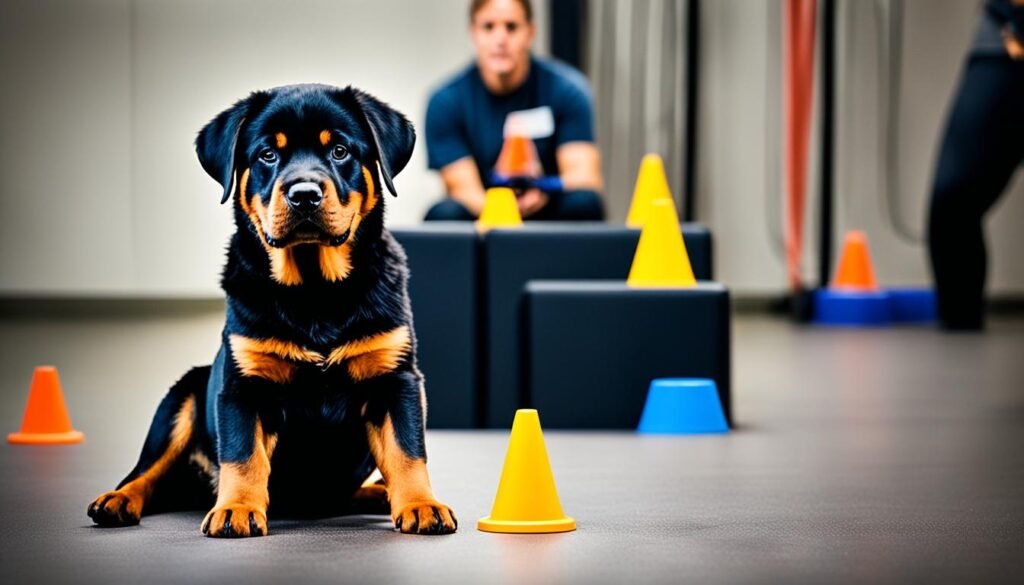
When it comes to Rottweiler training, it’s best to start early. Ideally, training should begin between 6 weeks and 6 months of age to establish a strong foundation for behavior and socialization skills.
During this critical period, it’s important to establish yourself as the leader and teach basic commands such as sit, stay, and come. These commands lay the groundwork for building good behavior and discipline in your Rottweiler.
Puppy socialization is also crucial for their overall well-being. Introducing them to different people, animals, and environments at an early age helps to develop their confidence and ensure they grow up to be well-rounded and friendly dogs.
It’s important to remember that Rottweilers are intelligent and eager to please their owners. This makes them responsive to training when done consistently and with positive reinforcement. Patience, consistency, and rewards are key in motivating and shaping their behavior.
To start your Rottweiler’s training journey, create a calm and positive environment, use a gentle tone, and always reward desired behavior. These simple training tips and early socialization will pave the way for a well-trained and well-behaved Rottweiler.
Steps to Effective Rottweiler Training
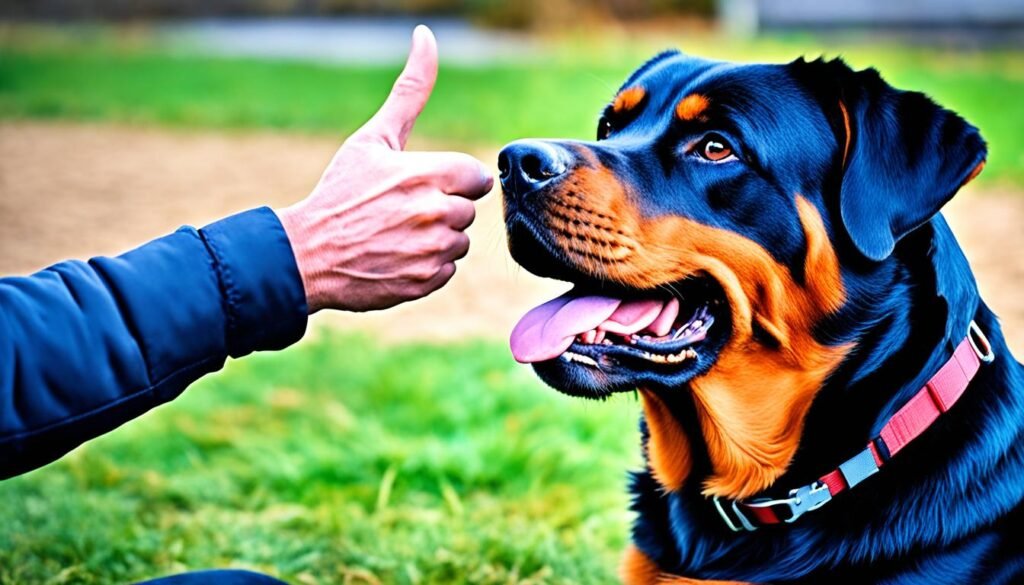
Training a Rottweiler can be a rewarding journey that strengthens the bond between you and your furry companion. To ensure successful training, it is essential to follow the right steps and employ positive reinforcement techniques. Here are the key steps to effective Rottweiler training:
Establishing Leadership
As the owner, it is crucial to establish yourself as the leader from the start. Rottweilers thrive when they have a clear hierarchy, and by asserting your position, you set the foundation for successful training. Show confidence, consistency, and provide clear rules and boundaries.
Socialization
Socialization is a vital aspect of training for Rottweilers. Exposing your furry friend to various environments, people, and other animals helps them become well-rounded and confident. Gradually introduce your Rottweiler to new experiences, ensuring positive interactions and rewarding good behavior along the way.
Positive Reinforcement
Positive reinforcement is a highly effective training method for Rottweilers. Reward desired behaviors, such as sitting on command, with treats, praise, or playtime. This approach motivates your Rottweiler and strengthens their desire to please you. Remember to be consistent and promptly reward good behavior to reinforce the desired actions.
Avoid Physical Discipline and Yelling
Physical discipline and yelling can be counterproductive during Rottweiler training. These tactics may instill fear or aggression, leading to negative associations with training sessions. Instead, focus on positive reinforcement techniques to foster a trusting and cooperative relationship with your Rottweiler.
Patience and Consistency
Training a Rottweiler requires patience and consistency. These intelligent dogs may take time to grasp commands fully, so it is important to remain patient and persistent. Be consistent with your training sessions, ensuring regular practice and repetition to reinforce their learning.
By following these steps, you can effectively train your Rottweiler and enjoy a harmonious relationship with your canine companion.
Key Commands for Rottweiler Training

Teaching your Rottweiler important commands is essential for their obedience and behavior. By mastering these commands, you can establish a strong bond and ensure a well-behaved companion. Here are some key commands that every Rottweiler owner should focus on:
1. Sit
The “sit” command is a fundamental command that teaches your Rottweiler to sit down on command. This command is useful in various situations, such as during mealtime or when encountering strangers. Begin by holding a treat close to your dog’s nose and then move it upwards, causing their head to follow it. As their head moves upward, their bottom will naturally lower into a sitting position. Once they are in a sitting position, praise them and give them the treat.
2. Down
The “down” command teaches your Rottweiler to lie down on command. This command helps to establish control and can be useful in situations where you want your dog to relax or stay calm. Start by getting your dog into a sitting position. Then, hold a treat in your hand and lower it to the ground in front of them, encouraging them to lie down. When they are in the down position, reward them with praise and the treat.
3. Stay
The “stay” command teaches your Rottweiler to remain in a position until you give them permission to move. This command is important for their safety, especially in situations where you want them to stay put, such as at a busy street or when visitors arrive. Begin by commanding your dog to sit or lie down. Then, with your palm facing towards them, say “stay” while taking a step backward. If they stay in position, reward them with praise and a treat. Gradually increase the distance and duration of the stay over time.
4. Come
The “come” command is crucial for ensuring that your Rottweiler returns to you on command. This command is essential for their safety and can prevent them from running off or getting into potentially dangerous situations. Start by getting down to their level and saying “come” in a friendly and inviting tone. Gently tug on their leash or use a treat as a lure to encourage them to come towards you. When they come to you, reward them with praise and a treat.
5. Paw
The “paw” command teaches your Rottweiler to give you their paw on command. This command is not only adorable but also a great way to engage with your dog. Start by commanding your dog to sit. Then, gently hold their paw in your hand and say “paw” while giving them praise. Reward them with a treat to reinforce the behavior. With consistent practice, your Rottweiler will learn to give you their paw when you give the command.
Remember, when teaching these commands, it’s important to use positive reinforcement techniques such as treats, praise, and affection. Consistency and patience are key, as it may take time for your Rottweiler to fully grasp these commands. Practice these commands in different settings and gradually increase the distractions to ensure that your Rottweiler can follow them reliably.
Addressing Rottweiler Behavior Issues

Rottweilers, like any other dog breed, can sometimes exhibit behavior problems that require attention and intervention. One common issue is aggression, which can manifest as excessive barking, growling, or even biting. It is important to address these behavior problems promptly and effectively to ensure the well-being and safety of both your Rottweiler and those around them.
To address behavior problems in Rottweilers, it is essential to provide proper training, exercise, and meet their specific needs. Here are some strategies to help manage and prevent such issues:
1. Training and Socialization
Consistent and positive training methods play a crucial role in addressing behavior problems in Rottweilers. Teaching commands such as “sit”, “stay”, and “leave it” can help them understand boundaries and appropriate behavior. Additionally, socializing your Rottweiler from a young age with people, animals, and various environments can reduce the likelihood of aggressive tendencies.
2. Mental and Physical Stimulation
Rottweilers are intelligent and energetic dogs that require both mental and physical stimulation. Engage them in interactive play, provide puzzle toys, and allocate time for regular exercise, such as walks or obedience training sessions. Keeping their minds and bodies active can prevent boredom and potential behavior problems.
3. Consistency and Structure
Establishing a consistent routine and clear rules within your household can help address behavior issues in Rottweilers. Dogs thrive in environments where expectations and boundaries are well-defined. Set consistent rules for behavior, reward good behavior, and redirect or correct undesirable behaviors promptly and consistently.
4. Seek Professional Help
If you’re facing significant challenges with your Rottweiler’s behavior, don’t hesitate to seek professional help. A professional dog trainer or behaviorist with experience working with Rottweilers can provide expert guidance tailored to your dog’s specific needs.
Remember, understanding that behavior problems can arise in any dog breed is essential. By addressing these issues head-on, providing appropriate training, and meeting their physical and mental needs, you can help your Rottweiler become a well-behaved and balanced companion.
Conclusion
Training a Rottweiler can be a rewarding experience when approached with the right techniques and strategies. Understanding the unique characteristics of the breed, establishing yourself as a leader, and consistently using positive reinforcement are essential for effective Rottweiler training.
While training challenges may arise due to their strong-willed nature, it is important to maintain patience, consistency, and ongoing commitment. These qualities are key in shaping a well-mannered and obedient Rottweiler.
With proper training and socialization, Rottweilers can transform into loyal and trustworthy companions. By investing time and effort into their training, you can create a strong bond with your Rottweiler and ensure they display good behavior both at home and in public settings.
FAQ
Are Rottweilers hard to train?
Rottweilers can be easy to train if approached correctly with patience, consistency, and positive reinforcement.
What are the characteristics of Rottweilers?
Rottweilers are a powerful breed known for their loyalty, intelligence, and protective nature.
Is Rottweiler training easy or difficult?
With the right training techniques and consistency, Rottweilers can be trained effectively.
Why are Rottweilers easy to train?
Rottweilers are intelligent and eager to please their owners, making them responsive to commands.
What challenges can arise in Rottweiler training?
Rottweilers can be strong-willed and stubborn, especially as puppies. Establishing leadership and maintaining consistency are important in training.
When should I start training my Rottweiler?
It is recommended to start training Rottweilers between 6 weeks and 6 months of age.
What are the steps to effective Rottweiler training?
Effective Rottweiler training involves establishing leadership, using positive reinforcement, and being consistent in training techniques.
What are the key commands for Rottweiler training?
Important commands to teach Rottweilers include sit, down, stay, come, and paw.
How can I address behavior issues in Rottweilers?
Proper training, exercise, and meeting their needs can help manage and prevent behavior problems in Rottweilers.
What is the importance of training challenges in Rottweilers?
Overcoming training challenges with patience and consistency can lead to an obedient and well-mannered Rottweiler.
